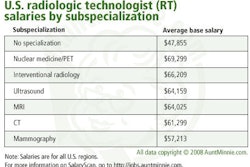Considering radiology's dramatic shift toward consolidation in the past decade amid rising healthcare costs, it's no surprise that the idea of teaming up appeals to physician groups as well.
Some radiology practices cast their lots with other radiology groups in an attempt to provide a more comprehensive service menu. But there's also more interest in merging with nonradiology groups, according to W. Kenneth Davis Jr. of the law firm Katten Muchin Rosenman in Chicago.
Mergers between radiology and nonradiology physician practices require a thorough process, and Davis gave attendees of the 2008 Radiology Business Management Association (RBMA) meeting in Las Vegas a framework to use as they consider taking this step. He defined "merger" as not only a true merger in the corporate law sense but also asset purchases that achieve the same objective.
"I don't advocate for or against mergers between radiology groups and nonradiology groups," Davis said. "But these deals are happening, and practices need to think the process through before getting into it."
Control and economics
Mergers between radiology and nonradiology physician practices tend to be sparked by control and economic issues rather than traditional legal and regulatory ones, Davis said. The deal goes more smoothly and has a better overall outcome if everyone involved addresses and resolves these issues upfront, before getting too far into the process. And mergers between different groups have inherent tension -- specialties that are accustomed to protecting their own turf are required to give up some of their control for the good of the merged group. The truth is that this may not be optimal for everyone.
"One or more of the specialties involved in a merger deal may be adversely affected to a disproportionate degree," Davis said.
Why merge? Reasons abound, according to Davis. Mergers can:
- Position groups better for payor contracting.
- Strengthen physicians of all specialties in dealings with hospitals and health systems.
- Integrate care.
- Streamline clinical operations.
- Give the new entity access to expanded ancillary services.
- Help groups share and reduce costs.
- Allow groups to share leadership and management skills.
- Put the radiology group in a more protected position long term.
Merger options
"The first question a radiology group should ask itself is whether it truly wants to merge with another, nonradiology group, and whether it's really ready to do it," Davis said. "Start thinking about what functions the group would share [and what would remain under the existing specialties]."
Davis outlined a few basic options for merging, including the following:
Full merger: Results in a single surviving entity with single tax identification and provider numbers. Physician ownership and governance is only in the merged group, and physicians become employees of the merged group. The new entity holds all payor contracts, as well as the exclusive provider agreements with hospitals.
Merger "lite": A new entity is formed with shared physician ownership; existing groups remain intact. Certain decisions could stay with the existing groups, while others transfer to the new entity. Medicare services might be billed by the new entity under its own tax ID number. Services for nongovernment payors could be billed by each respective group under their own tax ID numbers, which gives each group the ability to retain private payor contracts and exclusive provider agreements with hospitals. This arrangement can be difficult between radiology and nonradiology groups because of Stark law issues about self-referral.
Management services organization (MSO): Existing groups remain intact, but certain functions are transferred to the new entity and shared. All payor contracting is handled separately, and all services are billed separately.
Due diligence
Whatever option makes the most sense, performing due diligence on a few crucial aspects of the merger is key to the venture's success, Davis said.
Groups exploring whether to merge need to address antitrust issues by performing an analysis of the geographic and services market, and determining whether any competitively sensitive information that may be exchanged in the transaction creates antitrust risks. Parties should consider whether the merger can be done in a way that avoids the need to procure new payor contracts, if possible, and if not, consider whether the new entity will actually be able to obtain new contracts and what that will cost (will the payor extract higher fees or other concessions?).
As for navigating the Stark law, if technical component facilities or other ancillary services are important reasons for the merger, the new entity's physicians will need to comply with the in-office ancillary services exception the Stark law lays out, Davis said. And the same goes with the federal antikickback statute.
"The merger needs to be structured so it doesn't create antikickback issues," he said. "Everything needs to be done at fair market value, and can't take into account the volume or value of referrals generated among the merger parties."
Radiology groups interested in merging with nonradiology practices should also consider these questions:
- How much governance will be shared or centralized?
- What kind of protections will each specialty be given?
- What will be the top leadership roles, and who will fill them?
- Will professional component revenue be shared across specialties?
- How will ancillary services be handled?
- Do the groups want or need a transitional step before a full merger?
In a word, be meticulous when considering a merger, according to Davis. Make sure all groups involved in the merger sign a confidentiality agreement. And in particular, make sure that a merger is really desirable.
"Take the time to decide if a merger is right for the practice," he said. "Because once discussions start, it can be difficult to withdraw."
By Kate Madden Yee
AuntMinnie.com staff writer
June 12, 2008
Related Reading
The best way to run your practice? Look to corporate America, April 3, 2008
CMS anti-markup rule sparks more questions than answers, March 17, 2008
Want to survive in a post-DRA world? Start talking, March 4, 2008
'Purchasing Capital Equipment,' Part 3 -- Equipment assessment, October 26, 2007
'Purchasing Capital Equipment,' Part 2 -- Capital budget versus operating budget, October 17, 2007
Copyright © 2008 AuntMinnie.com




















